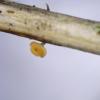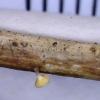
28-12-2025 12:08
Margot en Geert VullingsThis possible Karstenia was found on the bark of d

21-12-2025 21:32
Pol DebaenstHello, Garden, Burgweg 19, Veurne, BelgiumOn 10/1

26-12-2025 21:19
Arnold BüschlenPithyella chalaudii Priou. Ist als Bryoparasit in

21-12-2025 09:32
Hello.A tiny ascomycete found embedded in wood in

18-12-2025 21:17
Pol DebaenstThe identification took me to Byssonectria deformi

24-12-2025 17:08
Hulda Caroline HolteHello, I have found this propoloid ascomycete on
Hymenoscyphus ... possibly epiphyllus?
Alan Smith,
17-10-2017 22:55
Merci d'avance, Alan
Hans-Otto Baral,
18-10-2017 07:52

Re : Hymenoscyphus ... possibly epiphyllus?
Hi Alan
This is clearly Hymenoscyphus menthae (= H. consobrinus). You may consult my paper on this:
Hymenoscyphus menthae, H. macroguttatus and H. scutula, a
comparative taxonomic study emphasizing the value of spore
guttulation and croziers. Ascomycete.org, 7 (6) : 255-287. (2015)
Typical are the navicular multiguttulate, homopolar spores without a perceptible upper end.
This is a plurivorous species, like H. epiphyllus which differs in a consistently short stout stipe, and spores with large and small drops, also in having croziers at the ascus base.
Urtica and Rubus are very easily separated in a cross section. Urtica 4-angled with cavities in the xylem.
Zotto
This is clearly Hymenoscyphus menthae (= H. consobrinus). You may consult my paper on this:
Hymenoscyphus menthae, H. macroguttatus and H. scutula, a
comparative taxonomic study emphasizing the value of spore
guttulation and croziers. Ascomycete.org, 7 (6) : 255-287. (2015)
Typical are the navicular multiguttulate, homopolar spores without a perceptible upper end.
This is a plurivorous species, like H. epiphyllus which differs in a consistently short stout stipe, and spores with large and small drops, also in having croziers at the ascus base.
Urtica and Rubus are very easily separated in a cross section. Urtica 4-angled with cavities in the xylem.
Zotto
Alan Smith,
18-10-2017 16:19
Re : Hymenoscyphus ... possibly epiphyllus?
das ist sehr hilfreich, Zotto, danke




